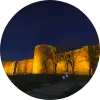
















Çayönü Höyük is an important mound located 7 kilometers southwest of the Ergani District, northwest of Diyarbakır city center. This historic settlement area spans a wide area and contains settlements from different periods. Additionally, Çayönü Höyük is a significant excavation site shedding light on a series of settlement phases from the Neolithic period to the Middle Ages, for archaeologists and historians alike.
The general features of Çayönü Höyük are as follows:
Location and Physical Characteristics: Situated northwest of Diyarbakır city center, in an area where the Boğazçay Stream flows to the south. It has a broad hill with dimensions of 160 x 350 meters and a height of 4.5 meters.
Settlement Phases: Excavations at Çayönü Höyük reveal an uninterrupted settlement phase from the Neolithic Age to the Middle Ages. These phases are divided based on architectural features and sub-phases.
Research and Excavations: Discovered as part of the "Prehistoric Southeast Anatolia Research" project initiated by Istanbul University and the University of Chicago in 1963. Excavations began in 1964 but were halted in 1992 due to terrorist incidents in the region.
Phases and Stratigraphy: Three main phases have been identified at Çayönü Höyük: Çayönü main phase (Neolithic Age without Pottery), Neolithic B phase without Pottery, Neolithic C phase without Pottery. Each phase contains different architectural phases and sub-phases.
Diet and Agriculture: Excavations indicate significant changes in dietary habits and agricultural practices between settlement phases. While hunting and gathering predominated in the early phases, animal husbandry and agriculture developed over time.
Archaeological Richness: Archaeological remains found at Çayönü Höyük are of great importance for understanding the region's historical process and lifestyle. Settlement plans provide detailed information about daily life and social organization.
Çayönü Höyük is an important area for archaeologists, providing a rich cultural heritage from Anatolia's Neolithic period.